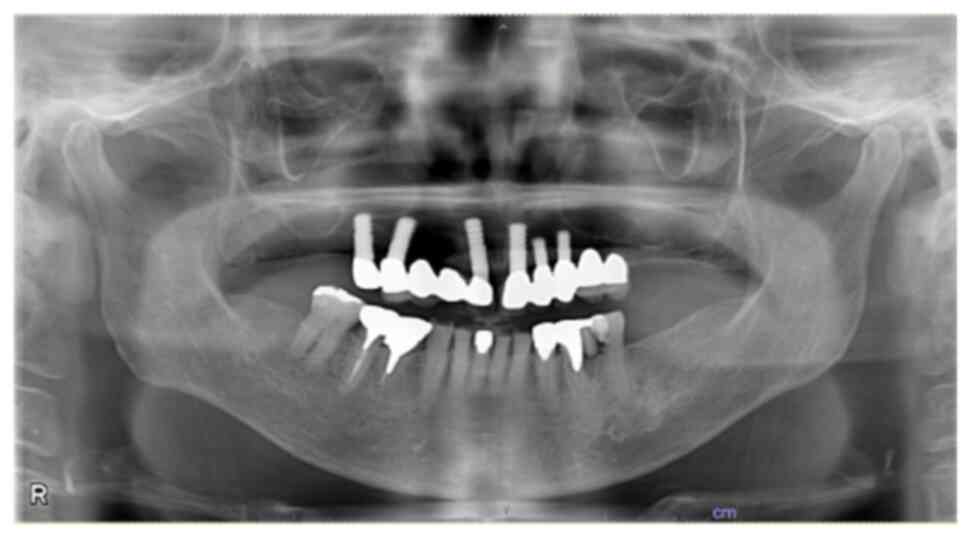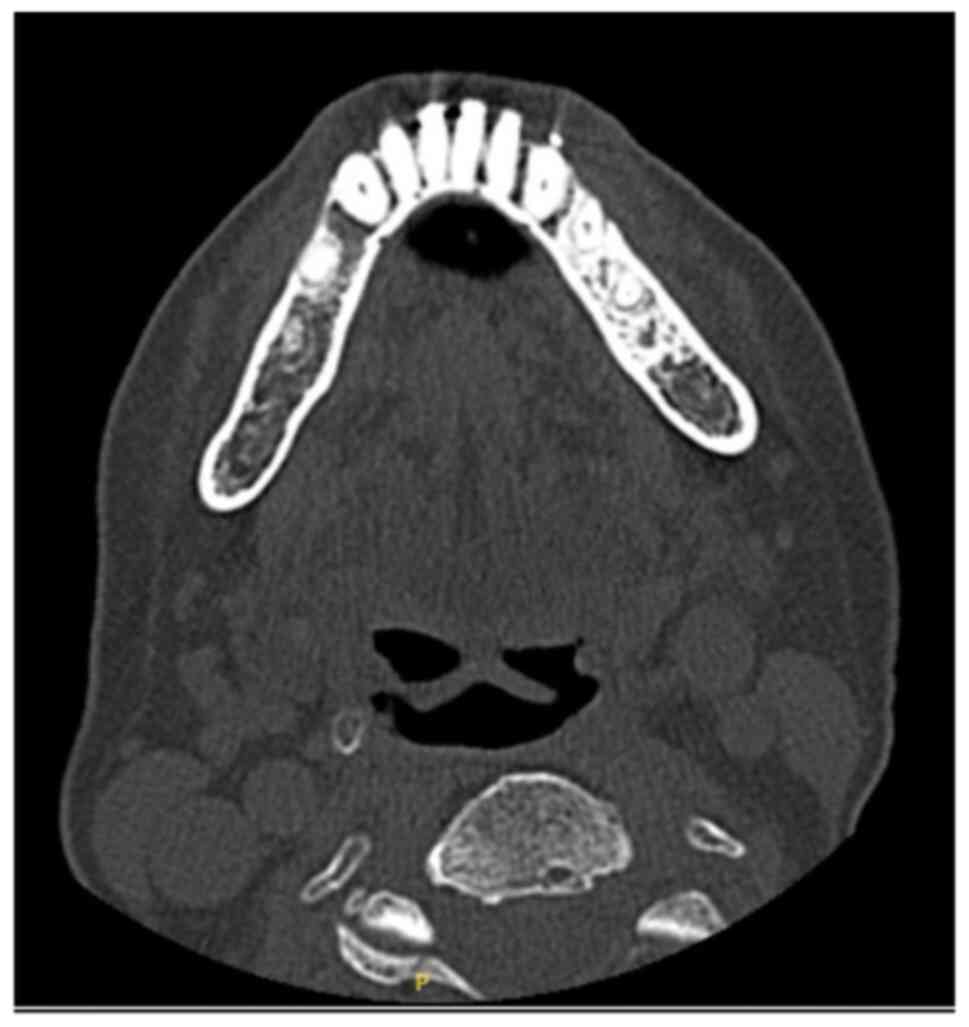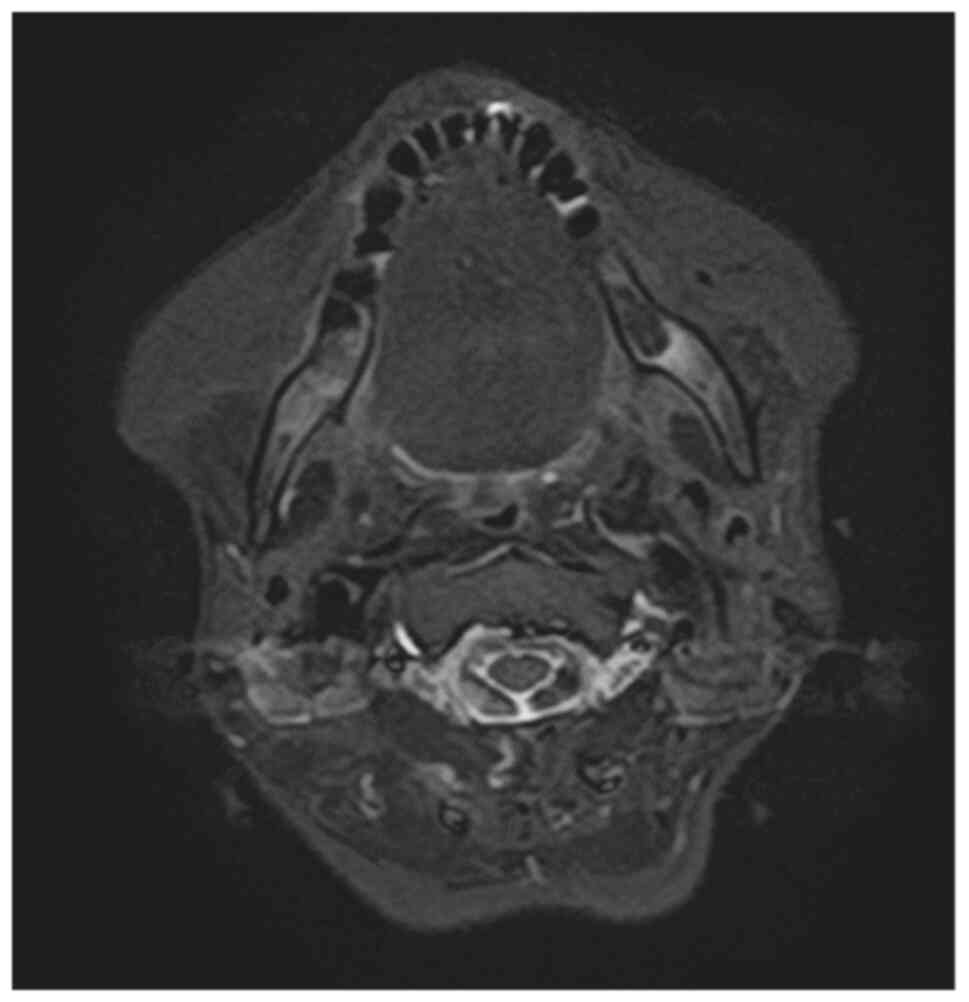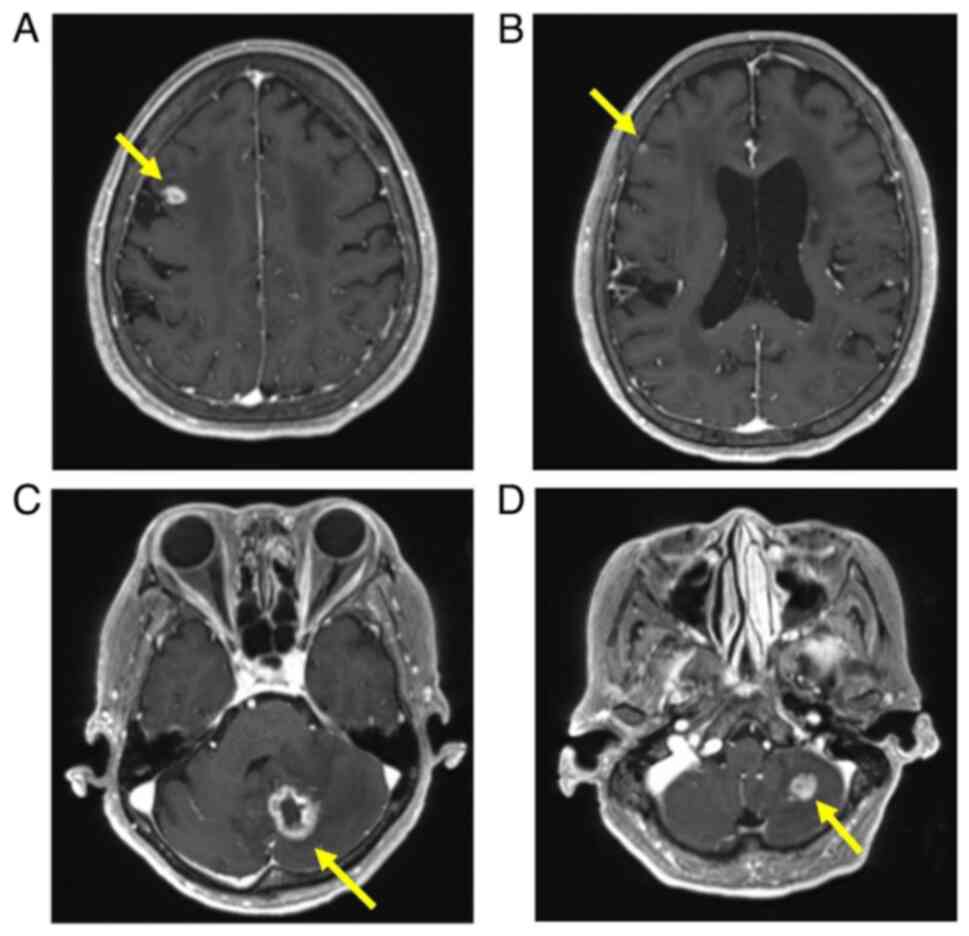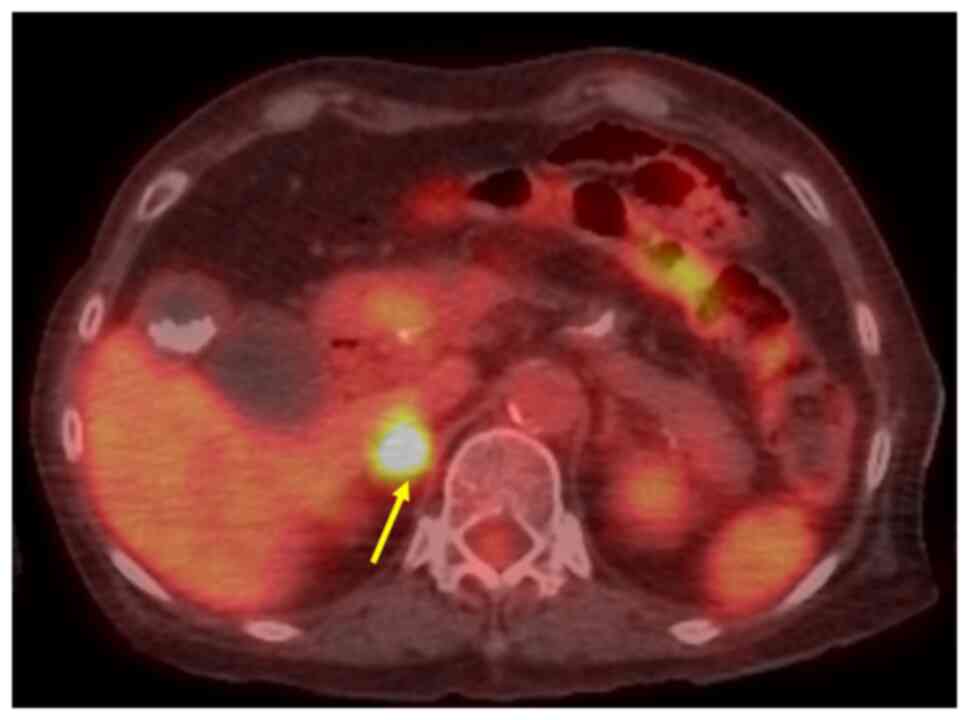Methotrexate‑related other iatrogenic immunodeficiency‑associated lymphoproliferative disorder in the CNS and medication‑related osteonecrosis of the jaw occurring simultaneously: A case report
- Authors:
- Published online on: November 28, 2023 https://doi.org/10.3892/etm.2023.12329
- Article Number: 41
-
Copyright: © Kato et al. This is an open access article distributed under the terms of Creative Commons Attribution License.
Abstract
Introduction
Methotrexate (MTX) is widely used to treat rheumatoid arthritis (RA) (1). However, it has been linked with MTX-associated lymphoproliferative disorder (MTX-LPD), a malignant lymphoma (2). According to the World Health Organization's (WHO) histological classification (Revision 4), MTX-LPD is currently classified as other iatrogenic immunodeficiency-associated LPD (OIIA-LPD), a subgroup of immunodeficiency-associated LPDs (IA-LPDs). Harigai (2) characterized MTX-LPD to be prevalent at an age of 60-70 years, associated with more than 10 years of MTX use, predominant in patients having B-cell non-Hodgkin's lymphoma, and in those having a positive laboratory test for Epstein-Barr virus (EBV). Spontaneous remission with the discontinuation of MTX alone is another feature (3,4), and this tendency is particularly strong in EBV-positive cases (5). MTX-OIIA-LPD is characterized by extranodal involvement at various sites, including the skin, lungs, muscles, and gastrointestinal tract (5). However, reports of MTX-OIIA-LPD involvement in the central nervous system (CNS) are rare, with only 15 cases reported in the literature (3,4,6-16), and none in the field of oral surgery. In the present study, we report the case of a patient with RA who developed lightheadedness and floating dizziness during treatment for medication-related osteonecrosis of the jaw (MRONJ). Furthermore, close examination revealed neoplastic lesions in the left cerebellum and the right frontal lobe, which proved to be diffuse B-cell lymphoma (DLBCL). Thus, a diagnosis of MTX-OIIA-LPD of the CNS was made. Also, we review the literature relevant to this case.
Case report
The patient was a 76-year-old woman, who presented to the referring dentist with a chief complaint of bone exposure and pain in the right mandibular molar. The patient was then referred to our department for further examination and treatment. Her medical history included MTX, iguratimod, and tocilizumab use, which were initiated in 2016 to treat RA. Alendronate sodium hydrate was also used in 2016 for the treatment of osteoporosis. However, a switch to denosumab was made in 2019 to control the progression of bone destruction caused by osteoporosis and RA. The patient had a stroke in 2000 but was independent in her activities of daily living. In 2021, the patient underwent endoscopic submucosal dissection for colorectal cancer at another hospital, and the pathological diagnosis was adenocarcinoma pT1b. No metastasis or recurrence was noted before her initial visit to our department.
At the initial examination, the patient experienced pain in the mandibular right molar and 65 (indicates right side mandibular) mobility, 6 mild swelling in the distal buccal gingiva, but no inflammation in the 6 proximal buccal and lingual gingiva and 54 buccal and lingual gingiva. Furthermore, 6 of the proximal to 5 buccal gingiva and 5 of the distal to 6 lingual gingiva showed bone exposure and retraction (Fig. 1). Panoramic radiography and computed tomography (CT) showed no obvious bone resorption or osteosclerosis in the 654 area (Figs. 2 and 3), and magnetic resonance imaging (MRI) showed high signal in the T2 short τ inversion recovery image (Fig. 4). Based on these clinical and imaging findings, the patient was diagnosed with MRONJ on the right side of the mandible. Amoxicillin was administered for anti-inflammatory purposes, and the patient's pain improved. At the follow-up visit, the patient was found to have severe lightheadedness and floating dizziness. Therefore, a CT scan was performed, which suggested a cerebellar infarction (Fig. 5). Subsequent MRI showed scattered neoplastic lesions in the left cerebellum and the right frontal lobe on gadolinium contrast T1-weighted volumetric interpolated breath-hold examination (Fig. 6). Neurosurgery was performed to remove the tumor from the cerebellum because of severe dizziness and nausea and anticipated tumor compression into the brainstem. As a metastatic brain tumor was suspected as the brain lesion, 2-[18F]-fluoro-2-deoxy-D-glucose positron emission tomography/computed tomography (FDG-PET/CT) was performed postoperatively for the purpose of a systemic search. No obvious lymphadenopathy or other lesions suggestive of malignancy were found, except for a strong accumulation of FDG in the right adrenal gland (Fig. 7). The pathological results showed DLBCL with CD20, CD30, and EBV positivity (Fig. 8). Peripheral blood EBV-PCR testing was performed within our hospital and results were detected at 70 copies/µg DNA but was not high; thus, retesting was deemed clinically unnecessary and was not performed during or after treatment. Because the patient had a history of MTX therapy and the central lesion was identified as DLBCL, the patient was diagnosed with MTX-OIIA-LPD. MTX treatment was immediately discontinued. Due to the patient's age and poor performance status, high-dose MTX was deemed difficult to tolerate. Whole-brain irradiation would have been an option if only central lesions were present; however, because of adrenal involvement, R-CHASE (cyclophosphamide, cytarabine, etoposide, dexamethasone, rituximab) was administered as systemic chemotherapy, including cytarabine, which has central transferring activity. During chemotherapy, oral care was performed regularly to prevent acute inflammation of the MRONJ in the mandibular right molar and keep the exposed bone area clean. However, the extent of bone exposure expanded to 7654. During the outpatient follow-up after chemotherapy, 654 had spontaneously fallen off; therefore, we sculpted the bone exposure area while waiting for the patient's physical condition to recover. The multiple brain lesions and MTX-OIIA-LPD lesions in the right adrenal gland completely disappeared eight months after onset. Subsequently, the patient's physical condition improved without recurrence, and the bone-exposed area became epithelialized.
Discussion
MTX-LPD is a lymphoproliferative disorder that occurs in patients receiving MTX and was first reported by Ellman et al (17) in 1991. Since then, similar reports have been published, and the term MTX-LPD has been proposed. In 2001, the WHO histological classification of hematopoietic and lymphoid tissue tumors (3rd edition) included the classification of MTX-LPD (1). However, in 2008, because LPD occurred with biological agents, such as anti-tumor necrosis factor-α agents and tacrolimus, in addition to MTX, the WHO Tissue Classification (4th edition) classified it as OIIA-LPD, a subgroup of IA-LPDs (18). According to WHO, the characteristics of MTX-OIIA-LPD are: (1) presence of RA (85% of patients with MTX-OIIA-LPD have RA), (2) similarity to lymphomas occurring in non-immunocompromised individuals, (3) EBV involvement (occurs in approximately half of the cases, and (4) most common type of lymphoma (35%) being DLBCL. On average, the disease occurs ~3 years (0.5-5.5 years) after MTX administration. Furthermore, 60% of patients achieve at least partial remission after discontinuation of MTX (1). In our case, all the characteristics were met.
Although MTX-OIIA-LPD is prone to extranodal involvement (19), there are few reports of MTX-OIIA-LPD in the CNS. We have identified 15 such reported cases in the literature (3,4,6-16) (Table I). The mean age of the patients in these cases was 67.7 years (range: 50-86 years, except for the patient in one case where the details were unknown), the primary disease was RA, and the mean duration of MTX use was 5.6 years (range: 2-13 years; reports stating more than 10 years were considered as 10 years). The histopathologic diagnoses were DLBCL in eight patients, T-cell lymphoma in two, pleomorphic/lymphoplasmacytic lymphoproliferative disease in one, and intravascular large B-cell lymphoma in one; in three cases, the primary disease was not described (20). Reportedly, EBV-DNA in the peripheral blood was positive in patients with MTX-OIIA-LPD who did not require chemotherapy after discontinuation of MTX and went into remission, whereas EBV-DNA was negative in patients who required chemotherapy.
Among the 15 cases of MTX-OIIA-LPD that developed in the CNS, 11 involved patients were EBV-positive. Among them, in 10 cases, the lesions resolved with interruption of MTX, whereas in one case, the tumor shrank after MTX withdrawal, but chemotherapy was administered because the tumor worsened. Considering that it takes ~4 weeks from MTX discontinuation to remission (19) and that remission is not achieved in all cases after MTX withdrawal, we decided that we could not wait for disease shrinkage by MTX discontinuation and decided to administer chemotherapy.
Several patients with RA also have osteoporosis (2), and a number of patients are likely to have been administered with MTX and bone resorption inhibitors concomitantly. However, There are few reports of cases with MRONJ and MTX-OIIA-LPD (21). Furthermore, to the best of our knowledge, there are no reports of concomitant MRONJ and CNS MTX-OIIA-LPD in the literature, as in our own case. Unless there is evidence of metastatic lesions to the jawbone in MRONJ, surgical biopsy is generally not recommended because of the possibility of exposing new fresh bone surfaces (22,23); thus, the diagnosis of MRONJ is made based on clinical symptoms (24) without biopsy. Furukawa et al (21) reported a case of MRONJ and MTX-OIIA-LPD in a patient who had been taking bisphosphonates (BP) and MTX. They reported that clinicians should keep in mind that intraoral MTX-OIIA-LPD is sometimes complicated by MRONJ, and that pathological examination is necessary for a final diagnosis.
There have been few reports of MTX-OIIA-LPD in the oral and maxillofacial region (21), and dentists are thought to be less aware of MTX-OIIA-LPD than MRONJ. We were able to identify only one case of MTX-OIIA-LPD and MRONJ occurring simultaneously in the oral and maxillofacial region (21). Moreover, our case is the first to report extraoral MTX-OIIA-LPD and MRONJ. Although simultaneous occurrence of MTX-OIIA-LPD and MRONJ is rare, when a patient with MRONJ is taking MTX, biopsy of the oral lesions should be performed considering oral and extraoral MTX-OIIA-LPD. In addition, systemic search should be performed in collaboration with related departments, such as rheumatology and hematology, to promptly diagnose MTX-OIIA-LPD and initiate prompt treatment. One of the side effects of MTX is dizziness. In our case, the patient already had CNS and progressive symptoms at the disease onset, different from MTX side effects, and imaging tests were performed, leading to the discovery of a neoplastic lesion in the brain. Neurosurgery was performed to remove the tumor from the cerebellum immediately because of severe dizziness and nausea and anticipated tumor compression into the brainstem and a pathological diagnosis was done. Thus, although MTX-OIIA-LPD of the CNS is rare, we were able to diagnose it early.
In conclusion, oral and maxillofacial surgeons should perform biopsies of oral lesions in patients with RA who are taking BP and MTX and have MRONJ. Further, collaboration with related diagnostic departments, such as rheumatology and hematology, is essential to enable early diagnosis and treatment of extraoral MTX-LPD. Moreover, although central MTX-LPD is rare, as in our case, it is also necessary to collaborate with neurosurgery and other related departments depending on the symptoms.
Acknowledgements
The authors would like to thank Dr Hiroki Yamada (Department of Neurosurgery, Graduate School of Medicine, Kyoto University, Kyoto, Japan) who contributed to the diagnosis and treatment of the patient.
Funding
Funding: No funding was received.
Availability of data and materials
The datasets used and/or analyzed during the current study are available from the corresponding author on reasonable request.
Authors' contributions
TK acquired the patient's clinical data, performed the literature review and edited the manuscript. TK, FI, TW, SY and SF contributed substantially to the conception and design of the study. CM and KN acquired data, provided clinical advice and revised the manuscript. TK played a major role in writing the manuscript. TK and CM confirm the authenticity of all the raw data. All the authors read and approved the final version of the manuscript.
Ethics approval and consent to participate
Not applicable.
Patient consent for publication
Written informed consent was obtained from the patient for the publication of this case report and accompanying images.
Competing interests
The authors declare that they have no competing interests.
References
|
Wang W, Zhou H and Liu L: Side effects of methotrexate therapy for rheumatoid arthritis: A systematic review. Eur J Med Chem. 158:502–516. 2018.PubMed/NCBI View Article : Google Scholar | |
|
Harigai M: Lymphoproliferative disorders in patients with rheumatoid arthritis in the era of widespread use of methotrexate: A review of the literature and current perspective. Mod Rheumatol. 28:1–8. 2018.PubMed/NCBI View Article : Google Scholar | |
|
Kleinschmidt-DeMasters BK, Damek DM, Lillehei KO, Dogan A and Giannini C: Epstein Barr virus-associated primary CNS lymphomas in elderly patients on immunosuppressive medications. J Neuropathol Exp Neurol. 67:1103–1111. 2008.PubMed/NCBI View Article : Google Scholar | |
|
Fukushima M, Katayama Y, Yokose N, Kura Y, Sawada U, Kotani A and Yoshino A: Primary central nervous system malignant lymphoma in a patient with rheumatoid arthritis receiving low-dose methotrexate treatment. Br J Neurosurg. 27:824–826. 2013.PubMed/NCBI View Article : Google Scholar | |
|
Hoshida Y, Xu JX, Fujita S, Nakamichi I, Ikeda J, Tomita Y, Nakatsuka S, Tamaru J, Iizuka A, Takeuchi T and Aozasa K: Lymphoproliferative disorders in rheumatoid arthritis: Clinicopathological analysis of 76 cases in relation to methotrexate medication. J Rheumatol. 34:322–331. 2007.PubMed/NCBI | |
|
Migita K, Miyashita T, Mijin T, Sakito S, Kurohama H, Ito M, Toda K, Tsustumi K, Baba H, Izumi Y, et al: Epstein-Barr virus and methotrexate-related CNS lymphoma in a patient with rheumatoid arthritis. Mod Rheumatol. 23:832–836. 2013.PubMed/NCBI View Article : Google Scholar | |
|
Liu W, Xue J, Yu S, Chen Q, Li X and Yu R: Primary central nervous system lymphoma mimicking recurrent depressive disorder: A case report. Oncol Lett. 9:1819–1821. 2015.PubMed/NCBI View Article : Google Scholar | |
|
Shimada H, Dobashi H, Morimoto H, Kameda T, Susaki K, Izumikawa M, Takeuchi Y, Nakashima S, Imataki O and Bandoh S: Primary central nervous system lymphoma in a rheumatoid arthritis patient treated with methotrexate: A case report. BMC Res Notes. 8(88)2015.PubMed/NCBI View Article : Google Scholar | |
|
Kikuchi J, Kaneko Y, Kasahara H, Emoto K, Kubo A, Okamoto S and Takeuchi T: Methotrexate-associated intravascular large B-cell lymphoma in a patient with rheumatoid arthritis. Intern Med. 55:1661–1665. 2016.PubMed/NCBI View Article : Google Scholar | |
|
Matsuda I and Hirota S: Methotrexate-associated lymphoproliferative disorder masquerading as multiple cerebral metastases. Br J Haematol. 180(628)2018.PubMed/NCBI View Article : Google Scholar | |
|
Miyaza S, Matsuda R, Nakamura M, Nakagawa I, Motoyama Y and Nakase H: Intracranial methotrexate-associated lymphoproliferative disorder in rheumatoid arthritis. World Neurosurg. 130:138–141. 2019.PubMed/NCBI View Article : Google Scholar | |
|
Kawazoe M, Kaneko K and Nanki T: Methotrexate-associated lymphoproliferative disorders in the central nervous system and stomach: A case report. Medicine (Baltimore). 99(e19850)2020.PubMed/NCBI View Article : Google Scholar | |
|
Uneda A, Hirashita K, Kanda T, Yunoki M, Yoshino K, Kurozumi K and Date I: rimary central nervous system methotrexate-associated lymphoproliferative disorder in a patient with rheumatoid arthritis: Case report and review of literature. NMC Case Rep J. 7:121–127. 2020.PubMed/NCBI View Article : Google Scholar | |
|
Kawano H, Kitamura T, Higuchi K and Nozaki K: Primary central nervous system T-cell lymphoma as methotrexate-associated lymphoproliferative disorders: Case report. NMC Case Rep J. 8:253–259. 2021.PubMed/NCBI View Article : Google Scholar | |
|
Ueno H, Ohno N, Abe T, Kimoto K, Matsuoka C, Giga M, Naito H, Kono T, Takasu M, Kidani N, et al: Prognosis prediction using magnetic resonance spectroscopy and oligoclonal bands in central nervous system methotrexate-associated lymphoproliferative disorder. Intern Med. 61:3733–3738. 2022.PubMed/NCBI View Article : Google Scholar | |
|
Mizushima M, Ishi Y, Ikeda H, Echizenya I, Otsuka T, Mitsuhashi T, Yamaguchi S and Fujimura M: Successful treatment of intracranial methotrexate-associated lymphoproliferative disorder without Epstein-Barr virus infection using rituximab, methotrexate, procarbazine, and vincristine: A case report. NMC Case Rep J. 9:237–242. 2022.PubMed/NCBI View Article : Google Scholar | |
|
Ellman MH, Hurwitz H, Thomas C and Kozloff M: Lymphoma developing in a patient with rheumatoid arthritis taking low dose weekly methotrexate. J Rheumatol. 18:1741–1743. 1991.PubMed/NCBI | |
|
Gaulard P, Swerdlow SH, Harris NL, Sundstrom C and Jaffe ES: Other iatrogenic immunodeficiency-associated lymphoproliferative disorders. In: Swerdlow SH, Campo E, Harris NL, Jaffe ES, Pileri SA, Stein H and Thiele J (eds). WHO classification of tumours of haematopoietic and lymphoid tissues. Revised 4th edition. IARC, Lyon, France, pp462-464, 2017. | |
|
Rizzi R, Curci P, Delia M, Rinaldi E, Chiefa A, Specchia G and Liso V: Spontaneous remission of ‘methotrexate-associated lymphoproliferative disorders’ after discontinuation of immunosuppressive treatment for autoimmune disease. Review of the literature. Med Oncol. 26:1–9. 2009.PubMed/NCBI View Article : Google Scholar | |
|
Katsuyama T, Sada KE, Yan M, Zeggar S, Hiramatsu S, Miyawaki Y, Ohashi K, Morishita M, Watanabe H, Katsuyama E, et al: Prognostic factors of methotrexate-associated lymphoproliferative disorders associated with rheumatoid arthritis and plausible application of biological agents. Mod Rheumatol. 27:773–777. 2017.PubMed/NCBI View Article : Google Scholar | |
|
Furukawa S, Oobu K, Moriyama M, Kawano S, Sako S, Hayashida JN, Matsubara R, Ogata KI, Kiyoshima T and Nakamura S: Oral methotrexate-related lymphoproliferative disease presenting with severe osteonecrosis of the jaw: A case report and literature review. Intern Med. 57:575–581. 2018.PubMed/NCBI View Article : Google Scholar | |
|
Ruggiero SL, Dodson TB, Assael LA, Landesberg R, Marx RE and Mehrotra B: American Association of Oral and Maxillofacial Surgeons. American association of oral and maxillofacial surgeons position paper on bisphosphonate-related osteonecrosis of the Jaws-2009 update. J Oral Maxillofac Surg. 67 (Suppl):S2–S12. 2009.PubMed/NCBI View Article : Google Scholar | |
|
Ficarra G and Beninati F: Bisphosphonate-related osteonecrosis of the Jaws: An update on clinical, pathological and management aspects. Head Neck Pathol. 1:132–140. 2007.PubMed/NCBI View Article : Google Scholar | |
|
Ruggiero SL, Dodson TB, Aghaloo T, Carlson ER, Ward BB and Kademani D: American association of oral and maxillofacial surgeons' position paper on medication-related osteonecrosis of the Jaws-2022 update. J Oral Maxillofac Surg. 80:920–943. 2022.PubMed/NCBI View Article : Google Scholar |




